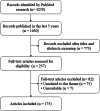Human seminal virome: a panel based on recent literature
- PMID: 36064315
- PMCID: PMC9444275
- DOI: 10.1186/s12610-022-00165-9
Human seminal virome: a panel based on recent literature
Abstract
Background: The seminal virome and its implications for fertility remain poorly understood. To date, there are no defined panels for the detection of viruses of clinical interest in seminal samples.
Results: In this study, we characterized the human seminal virome based on more than 1,000 studies published over the last five years.
Conclusions: The number of studies investigating viruses that occur in human semen has increased, and to date, these studies have been mostly prospective or related to specific clinical findings. Through the joint analysis of all these studies, we have listed the viruses related to the worsening of seminal parameters and propose a new panel with the main viruses already described that possibly affect male fertility and health. This panel can assist in evaluating semen quality and serve as a tool for investigation in cases of infertility.
RéSUMé: CONTEXTE: Le virome séminal et ses implications pour la fertilité restent mal compris. À ce jour, il n’existe pas de panels définis pour la détection des virus d’intérêt clinique dans les échantillons de sperme. RéSULTATS: Dans cette étude, nous avons caractérisé le virome séminal humain sur la base de plus de 1000 études publiées au cours des cinq dernières années. CONCLUSIONS: Le nombre d’études portant sur les virus présents dans le sperme humain a augmenté et, à ce jour, ces études ont principalement été prospectives ou liées à des résultats cliniques spécifiques. Grâce à l’analyse conjointe de toutes ces études, nous avons répertorié les virus liés à l’aggravation des paramètres spermatiques, et nous proposons un nouveau panel avec les principaux virus déjà décrits qui peuvent affecter la fertilité et la santé masculines. Ce panel peut aider à évaluer la qualité du sperme et servir d’outil d’investigation dans les cas d’infertilité.
Keywords: HBV; HCV; HIV; HPV; SARS-COV-2; infertility; semen; viral semen infection.
© 2022. The Author(s).
Conflict of interest statement
The authors declare that they have no competing interests.
Figures




References
-
- World Health Organization (WHO) International Classification of Diseases, 11th Revision (ICD-11) Geneva: WHO; 2018.
Publication types
LinkOut - more resources
Full Text Sources
Miscellaneous

